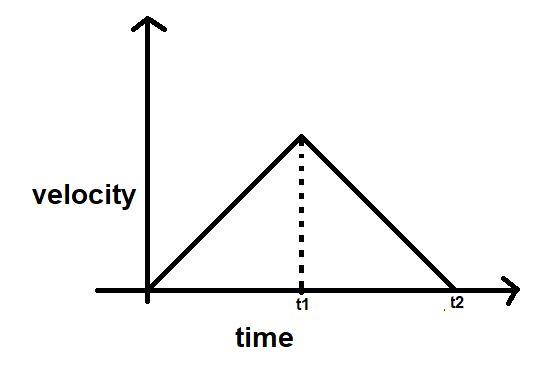
A scooter accelerates from rest for time\[{t_1}\] at constant rate \[{\alpha _1}\;\]and then retards at constant rate \[{\alpha _{2\;}}\] for time\[{t_2}\] and comes to rest. The correct value of \[{t_1}/{t_2}\;\] will be
a. \[({\alpha _1}\; + {\text{ }}{\alpha _2})/{\alpha _2}\]
b. \[{\alpha _2}/{\alpha _1}\]
c. \[({\alpha _1}\; + {\text{ }}{\alpha _2})/{\alpha _1}\]
d. \[{\alpha _1}/{\alpha _2}\]
Answer
218.4k+ views
Hint: It is given that scooter accelerates at a constant rate means that that it does not change with time. In other words, velocity is increasing uniformly. This is the case of uniform acceleration. Uniform acceleration is given by change of velocity per unit time. There are two cases of the question. First is when the scooter is accelerating and other is retardation that is negative acceleration.
Complete answer:
Case\[1\]:
The scooter is starting from rest. Thus, initial velocity is zero. Thus, final velocity per unit time gives the value of acceleration.
Substituting all the data in the form of equation, we write:
\[{\alpha _1} = \frac{v}{{{t_1}}}\] ……….(1)
Where,
\[{\alpha _1}\] is the acceleration and v is the final velocity reached in time \[{t_{1.}}\]
Case\[2\]:
The scooter retards for time \[{t_2}\] at a rate \[{\alpha _{2.}}\]
Thus, retardation is given by negative of difference of final and initial velocity. Or it is correct to say that it is initial velocity minus the final velocity. The final velocity of case first becomes the initial velocity of the case second. Thus, initial velocity is v. Also, the scooter finally comes to rest so final is zero.
Thus in form of mathematical equation
\[{\alpha _2} = \frac{v}{{{t_2}}}\] ……..(2)
Dividing the two equations to get ratio $\frac{{{t_1}}}{{{t_2}}}$
$\frac{{{t_1}}}{{{t_2}}} = \frac{{{\alpha _2}}}{{{\alpha _1}}}$
Thus, the correct option is b.
Note: A graph can be plotted depicting the above situation. As scooter starts from rest, its velocity increases uniformly. Thus, a straight line starting from zero that has increasing slope. Then the scooter retards so a straight line with decreasing slope till zero because the scooter again comes to rest position.

Complete answer:
Case\[1\]:
The scooter is starting from rest. Thus, initial velocity is zero. Thus, final velocity per unit time gives the value of acceleration.
Substituting all the data in the form of equation, we write:
\[{\alpha _1} = \frac{v}{{{t_1}}}\] ……….(1)
Where,
\[{\alpha _1}\] is the acceleration and v is the final velocity reached in time \[{t_{1.}}\]
Case\[2\]:
The scooter retards for time \[{t_2}\] at a rate \[{\alpha _{2.}}\]
Thus, retardation is given by negative of difference of final and initial velocity. Or it is correct to say that it is initial velocity minus the final velocity. The final velocity of case first becomes the initial velocity of the case second. Thus, initial velocity is v. Also, the scooter finally comes to rest so final is zero.
Thus in form of mathematical equation
\[{\alpha _2} = \frac{v}{{{t_2}}}\] ……..(2)
Dividing the two equations to get ratio $\frac{{{t_1}}}{{{t_2}}}$
$\frac{{{t_1}}}{{{t_2}}} = \frac{{{\alpha _2}}}{{{\alpha _1}}}$
Thus, the correct option is b.
Note: A graph can be plotted depicting the above situation. As scooter starts from rest, its velocity increases uniformly. Thus, a straight line starting from zero that has increasing slope. Then the scooter retards so a straight line with decreasing slope till zero because the scooter again comes to rest position.

Recently Updated Pages
Chemical Properties of Hydrogen - Important Concepts for JEE Exam Preparation

JEE General Topics in Chemistry Important Concepts and Tips

JEE Atomic Structure and Chemical Bonding important Concepts and Tips

JEE Amino Acids and Peptides Important Concepts and Tips for Exam Preparation

JEE Extractive Metallurgy Important Concepts and Tips for Exam Preparation

Algebra Made Easy: Step-by-Step Guide for Students

Trending doubts
JEE Main 2026: Application Form Open, Exam Dates, Syllabus, Eligibility & Question Papers

Derivation of Equation of Trajectory Explained for Students

Hybridisation in Chemistry – Concept, Types & Applications

Understanding the Angle of Deviation in a Prism

Understanding Collisions: Types and Examples for Students

Understanding Atomic Structure for Beginners

Other Pages
JEE Advanced Marks vs Ranks 2025: Understanding Category-wise Qualifying Marks and Previous Year Cut-offs

Units And Measurements Class 11 Physics Chapter 1 CBSE Notes - 2025-26

NCERT Solutions For Class 11 Physics Chapter 8 Mechanical Properties Of Solids

Motion in a Straight Line Class 11 Physics Chapter 2 CBSE Notes - 2025-26

NCERT Solutions for Class 11 Physics Chapter 7 Gravitation 2025-26

How to Convert a Galvanometer into an Ammeter or Voltmeter




